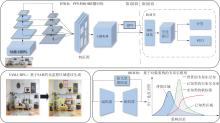Journal of South China University of Technology(Natural Science Edition) ›› 2025, Vol. 53 ›› Issue (3): 12-19.doi: 10.12141/j.issn.1000-565X.240109
• Computer Science & Technology • Previous Articles Next Articles
An Open-World Object Detection Method of Capable of Addressing Label Bias Issues
HUANG Yangyang, XU Yong, XI Xing, LUO Ronghua
- School of Computer Science and Engineering,South China University of Technology,Guangzhou 510006,Guangdong,China
-
Received:2024-03-11Online:2025-03-25Published:2024-07-05 -
Contact:罗荣华(1975—),男,博士,副教授,主要从事智能机器人、机器人视觉、机器人认知原理研究。 E-mail:rhluo@scut.edu.cn -
About author:黄阳阳(1992—),男,博士生,主要从事计算机视觉和深度学习研究。E-mail: huangyangy@whu.edu.cn -
Supported by:the National Key R & D Program of China(2024YFE0105400)
CLC Number:
Cite this article
HUANG Yangyang, XU Yong, XI Xing, LUO Ronghua. An Open-World Object Detection Method of Capable of Addressing Label Bias Issues[J]. Journal of South China University of Technology(Natural Science Edition), 2025, 53(3): 12-19.
share this article
Table 1
Comparison of performance among five open world object detection models"
| 模型 | 召回率/% | mAP_pk/% | mAP_ck/% | mAP_bo/% | ||||||||||||
|---|---|---|---|---|---|---|---|---|---|---|---|---|---|---|---|---|
| T1 | T2 | T3 | T4 | T1 | T2 | T3 | T4 | T1 | T2 | T3 | T4 | T1 | T2 | T3 | T4 | |
| ORE-EBUI | 1.5 | 3.9 | 3.6 | 61.0 | 43.1 | 33.6 | 71.4 | 30.9 | 32.2 | 26.3 | 45.6 | 39.5 | 31.8 | |||
| OW-DETR | 5.7 | 6.2 | 6.9 | 65.0 | 46.7 | 38.2 | 73.1 | 29.0 | 25.7 | 28.1 | 46.0 | 39.7 | 33.1 | |||
| PROB | 17.6 | 22.3 | 24.8 | 66.3 | 51.2 | 42.6 | 73.5 | 36.0 | 30.4 | 31.7 | 50.4 | 42.0 | 39.9 | |||
| CAT | 24.0 | 23.0 | 24.6 | 67.6 | 50.2 | 45.4 | 74.2 | 35.5 | 32.6 | 35.1 | 50.7 | 45.0 | 42.8 | |||
| 文中模型 | 52.1 | 50.4 | 45.7 | 67.1 | 48.3 | 43.5 | 73.3 | 36.5 | 33.9 | 33.6 | 51.6 | 43.5 | 40.9 | |||
| 1 | REN S, HE K, GIRSHICK R,et al . Faster R-CNN:towards real-time object detection with region proposal networks [J].IEEE Transactions on Pattern Analysis and Machine Intelligence,2017,39(6):1137-1149. |
| 2 | REDMON J, DIVVALA S, GIRSHICK R,et al .You only look once:unified,real-time object detection [C]∥ Proceedings of 2016 IEEE Conference on Computer Vision and Pattern Recognition.Las Vegas:IEEE,2016:779-788. |
| 3 | LIN T Y, GOYAL P, GIRSHICK R,et al .Focal loss for dense object detection [J].IEEE Transactions on Pattern Analysis and Machine Intelligence,2020,42(2):318-327. |
| 4 | ZHU X, SU W, LU L,et al . Deformable DETR:deformable transformers for end-to-end object detection [C]∥ Proceedings of the 9th International Conference on Learning Representations.Vienna:OpenReview.net,2021:1-16. |
| 5 | DHAMIJA A, GÜNTHER M, VENTURA J,et al .The overlooked elephant of object detection:open set [C]∥ Proceedings of 2020 IEEE Winter Conference on Applications of Computer Vision.Snowmass:IEEE,2020:1010-1019. |
| 6 | JOSEPH K J, KHAN S, KHAN F S,et al .Towards open world object detection [C]∥ Proceedings of 2021 IEEE/CVF Conference on Computer Vision and Pattern Recognition.Nashville:IEEE,2021:5826-5836. |
| 7 | GUPTA A, NARAYAN S, JOSEPH K J,et al .OW-DETR:open-world detection transformer[C]∥ Proceedings of 2022 IEEE/CVF Conference on Computer Vision and Pattern Recognition.New Orleans:IEEE,2022:9225-9234. |
| 8 | ZOHAR O, WANG K C, YEUNG S .PROB:probabilistic objectness for open world object detection [C]∥ Proceedings of 2023 IEEE/CVF Conference on Computer Vision and Pattern Recognition.Vancouver:IEEE,2023:11444-11453. |
| 9 | MA S, WANG Y, WEI Y,et al .CAT:localization and identification cascade detection transformer for open-world object detection [C]∥ Proceedings of 2023 IEEE/CVF Conference on Computer Vision and Pattern Recognition.Vancouver:IEEE,2023:19681-19690. |
| 10 | DONG N, ZHANG Y, DING M,et al .Open world DETR:transformer based open world object detection [EB/OL].(2022-12-06)[2024-03-05].. |
| 11 | WANG X, YU Z, DE MELLO S,et al .FreeSOLO:learning to segment objects without annotations [C]∥ Proceedings of 2022 IEEE/CVF Conference on Computer Vision and Pattern Recognition. New Orleans:IEEE,2022:4156-4166. |
| 12 | BAR A, WANG X, KANTOROV V,et al .DETReg:unsupervised pretraining with region priors for object detection [C]∥ Proceedings of 2022 IEEE/CVF Conference on Computer Vision and Pattern Recognition.New Orleans:IEEE,2022:14585-14595. |
| 13 | KIRILLOV A, MINTUN E, RAVI N,et al .Segment anything [C]∥ Proceedings of 2023 IEEE/CVF International Conference on Computer Vision.Paris:IEEE,2023:3992-4003. |
| 14 | ZHOU Y .Rethinking reconstruction autoencoder-based out-of-distribution detection [C]∥ Proceedings of 2022 IEEE/CVF Conference on Computer Vision and Pattern Recognition.New Orleans:IEEE,2022:7369-7377. |
| 15 | JIANG W, GE Y, CHENG H,et al . READ:aggregating reconstruction error into out-of-distribution detection [C]∥ Proceedings of the 37th AAAI Conference on Artificial Intelligence.Washington D C:AAAI,2023:14910-14918. |
| 16 | OSADA G, TAKAHASHI T, AHSAN B,et al .Out-of-distribution detection with reconstruction error and typicality-based penalty [C]∥ Proceedings of 2023 IEEE/CVF Winter Conference on Applications of Computer Vision.Waikoloa:IEEE,2023:5540-5552. |
| 17 | FANG R H, PANG G S, ZHOU L,et al .Unsupervised recognition of unknown objects for open-world object detection [EB/OL]. (2023-08-31)[2024-03-05].. |
| 18 | SHMELKOV K, SCHMID C, ALAHARI K .Incremental learning of object detectors without catastrophic forgetting[C]∥ Proceedings of 2017 IEEE International Conference on Computer Vision.Venice:IEEE,2017:3420-3429. |
| 19 | HAO Y, FU Y, JIANG Y,et al .An end-to-end architecture for class-incremental object detection with knowledge distillation [C]∥ Proceedings of 2019 IEEE International Conference on Multimedia and Expo.Shanghai:IEEE,2019:1-6. |
| 20 | YANG B, DENG X, SHI H,et al .Continual object detection via prototypical task correlation guided gating mechanism[C]∥ Proceedings of 2022 IEEE/CVF Conference on Computer Vision and Pattern Recognition.New Orleans:IEEE,2022:9245-9254. |
| 21 | HE K, GKIOXARI G, DOLLÁR P,et al .Mask R-CNN [C]∥ Proceedings of 2017 IEEE International Conference on Computer Vision.Venice:IEEE,2017:2980-2988. |
| 22 | WEI F, GAO Y, WU Z,et al .Aligning pretraining for detection via object-level contrastive learning[C]∥ Proceedings of the 35th International Conference on Neural Information Processing Systems.Red Hook:Curran Associates Inc., 2021:22682-22694. |
| 23 | LI Z, HOIEM D .Learning without forgetting[C]∥Proceedings of the 14th European Conference on Computer Vision.Amsterdam:Springer,2016:614-629. |
| 24 | DHAR P, SINGH R V, PENG K C,et al .Learning without memorizing[C]∥ Proceedings of 2019 IEEE/CVF Conference on Computer Visionand Pattern Recognition.Long Beach:IEEE,2019:5133-5141. |
| 25 | HE K, ZHANG X, REN S,et al .Deep residual learning for image recognition [C]∥ Proceedings of 2016 IEEE Conference on Computer Vision and Pattern Recognition.Las Vegas:IEEE,2016:770-778. |
| 26 | UIJLINGS J R, GEVERS T, SMEULDERS W A .Selective search for object recognition[J].International Journal of Computer Vision,2013,104(2):154-171. |
| [1] | LUO Yutao, MAO Haojie. Single-Stage Object Detection Algorithm with Enhanced Pillar Feature Encoding [J]. Journal of South China University of Technology(Natural Science Edition), 2025, 53(3): 1-11. |
| [2] | YUE Yongheng, LEI Wenpeng. Foggy Road Environment Perception Algorithm Based on an Improved CycleGAN and YOLOv8 [J]. Journal of South China University of Technology(Natural Science Edition), 2025, 53(2): 48-57. |
| [3] | YUE Yongheng, NING Ruihou. Intelligent Vehicle Object Detection Algorithm Based on Lightweight CenterNet [J]. Journal of South China University of Technology(Natural Science Edition), 2024, 52(8): 45-55. |
| [4] | GUO Enqiang, FU Xinsha. Dropped Object Detection Method Based on Feature Similarity Learning [J]. Journal of South China University of Technology(Natural Science Edition), 2023, 51(6): 30-41. |
| [5] | DU Qiliang, XIANG Zhaoyi, TIAN Lianfang. Real Time Statistics Method of Escalator Passenger Flow for Embedded Devices [J]. Journal of South China University of Technology(Natural Science Edition), 2022, 50(6): 60-70. |
| [6] | YI Qingming, LÜ Renyi, SHI Min, et al. Lightweight Object Detection Combined with Multi-Scale Dilated-Convolution and Multi-Scale Deconvolution [J]. Journal of South China University of Technology(Natural Science Edition), 2022, 50(12): 41-48. |
| [7] | TAN Guang LI Changhao ZHAN Zhaohuan. Adaptive Scheduling Algorithm for Object Detection and Tracking Based on Device-Cloud Collaboration [J]. Journal of South China University of Technology (Natural Science Edition), 2021, 49(7): 86-93. |
| [8] | LI Bo RAO Haobo. Salient Object Detection Based on Feature Enhancement in Complex Scene [J]. Journal of South China University of Technology (Natural Science Edition), 2021, 49(11): 135-144. |
| [9] | LIU Weiming, WEN Junrui, ZHENG Zhongxing, et al. DifferentNet: Neural Network for Foreign Objects Foreground Detection in Metro [J]. Journal of South China University of Technology(Natural Science Edition), 2021, 49(10): 11-21,40. |
| [10] | WU Qiuxia, LI Lingmin. 3D Object Detection Based on Point Cloud Bird's Eye View Remapping [J]. Journal of South China University of Technology(Natural Science Edition), 2021, 49(1): 39-46. |
| [11] | LIU Yujie CAO Xianzhi LI Zongmin LI Hua. Video Object Detection Based on Correlation Feature and Convolutional Neural Network [J]. Journal of South China University of Technology(Natural Science Edition), 2018, 46(12): 26-33. |
| [12] | Fu Xin-sha Wang Xiang-bo Li Hai-feng Meng Qing-xin. Detection Algorithm of Expressway Moving Objects Based on Background Subtraction [J]. Journal of South China University of Technology (Natural Science Edition), 2015, 43(4): 1-6. |
| [13] | Guo Ling Li Zhen-zhen Du Ming-hui. Moving Target Tracking Based on Monocular Sequence Images [J]. Journal of South China University of Technology(Natural Science Edition), 2012, 40(3): 94-99. |
| [14] | Luo Rong-hua Min Hua-qing. Hybrid Conditional Random Field for Multi-Object Tracking of Mobile Robot [J]. Journal of South China University of Technology (Natural Science Edition), 2011, 39(5): 61-67. |
| Viewed | ||||||
|
Full text |
|
|||||
|
Abstract |
|
|||||



